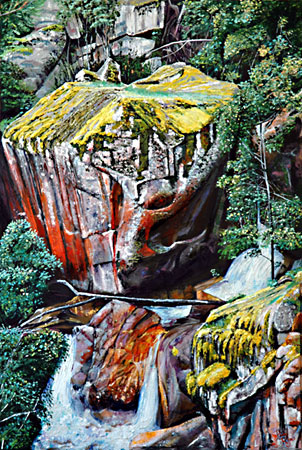Use of 3D surfaces
An aspect of many Myopic Landscapes paintings that is difficult to capture on a website is the 3 dimensional (3D) features they contain. Within the painting descriptions in the catalogue the various techniques used to create these feature are simplistically described as mixed media.
Part of the history of art has been the development and use of flat surfaces to support paint. True flat surfaces are rare in nature. Cave walls and even flattened bark are not evenly flat and this makes painting difficult and limited in size. Development of architecture and plastered walls produced large vertical surfaces for monumental decoration such as frescos. Some of these decorations were partially 3D such as the bas-reliefs of the Egyptian temples. But it was the invention of canvas stretched over a wooden frame that was the great innovation for painting, making it easy to have flat surfaces of any size (but still relatively light weight) that readily take paint. This is still the standard technology used today. However, one of the disadvantages of stretched canvas is that it cannot support thick media or objects other than paint without some structural reinforcement.
Compared to canvas, it had been difficult to produce light-weight flat wooden surfaces suitable for painting until the development panel products such as plywood, masonite, and more recently medium-density fibreboard (MDF). 3mm thick MDF sheets make ideal painting surfaces, especially if you want to add bulky or weighty media onto the painting.
The inherent paradox of landscape painting is that you want to depict a 3D scene onto a 2 dimensional (2D) surface. There have been numerous painting and drawing techniques developed since the Renaissance directed towards producing the optical illusion of 3D on a 2D surface. These techniques include perspective grids, shadowing and colour diffusion. We are so familiar with them in art that a lot of 20th Century art movements purposely ignored dimensionality to make us look anew at subjects. Aboriginal art also depicts landscape without dimensional constraints.
In more conventional, non-abstract landscape painting, the various painting techniques used to produce the illusion of 3D have become mundane, even banal to a point where the viewer takes it for granted. In his painting Phil tries to undermine this response, by producing a partial paradox of 3D illusion and actuality. He does this by enhancing the optical illusion of depth in predominantly 2D landscape paintings by selectively producing 3D features rising off the flat surface; while at the same time, awakening the viewer to the deception of 3D illusion across the bulk of the painting. The overall effect he wants to achieve is to capture the viewer's "minds-eye" in the illusion of perspective and make them reconsider all parts of the painting's dimensionality.
Mixed media in the Myopic Landscapes paintings
The use of mixed media in the Myopic Landscapes paintings is dictated by the painting subject matter and composition. It is not used for just gimmick's sake. Mixed media is mostly used to produce the following effects:
Variable texture to enhance surface roughness
Phil uses variable texture to enhance surface roughness of the acrylic paint and hence the perspective illusion.
Objects in the foreground are rougher and coarser than those in the background. Media such as differing size-grain sand or glass beads are applied within a acrylic medium. There are also many different textured commercial art media available. This is one of the advantages of modern acrylic artists paints.
Texture contrast to enhance the illusion of subject variation
Phil uses texture contrast to enhance the illusion of subject variation.
An example is depicting water, it can be enhanced by the use of semi-transparent gel mediums, this can also contrast it with the rougher (granular) texture of rocks or a sandy shore.
Sculptural bas-relief of certain objects in the painting foreground
For subjects with significant interesting foreground detail, Phil sometimes uses sculptural bas-relief of some of the objects in the painting foreground. These surfaces are formed and sculptured using several types of acrylic modelling compounds.
Multiple sheets of MDF in a single painting
A landscape painting can have an enhanced theatical dimension.
Phil uses partial sheets of MDF, stacked to represent areas at a common distance within the view being capture. There is an analogy here with how scenery panels are positioned in theatre sets for the illusion of 3D landscape.
Find out more about Phil's art:


